Do you have a sales plan? Entrepreneurs, sales executives, and sales managers all benefit from writing sales plans — whether for their business, department, or team. You must know where you're going before you can hit your key targets, and from there, you must break down the strategies and tactics you'll use to do it.

All of this information can be included in a sales plan (and more). Read on to learn how to draft a sales plan that's right for your organization.
Free Download: Sales Plan Template
In this post, we'll cover:
What Is a Sales Plan?
What Is the Sales Planning Process?
What Goes In a Sales Plan Template
How to Write a Sales Plan
Tips for Creating an Effective Sales Plan
Sales Plan Examples
Strategic Sales Plan Templates
What is a sales plan?
Sales plans often include information about the business' target customers, revenue goals, team structure, and the strategies and resources necessary for achieving its targets.
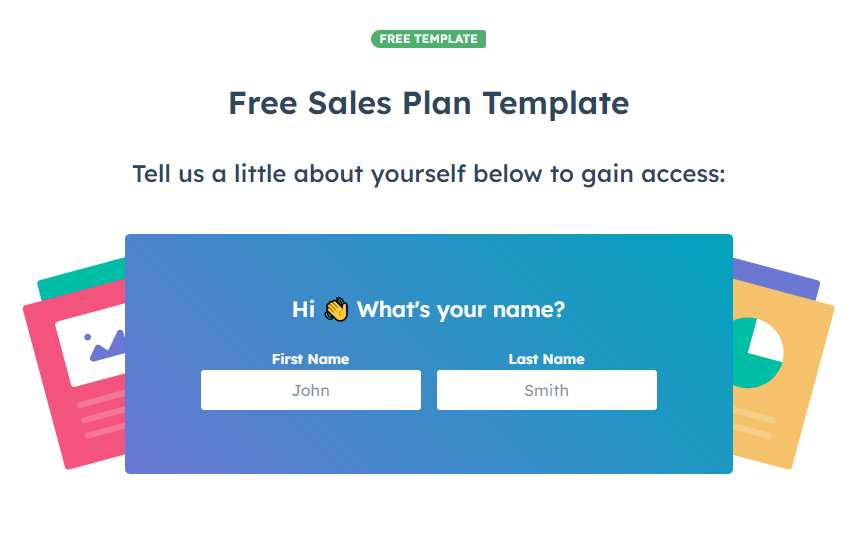
What are the goals of an effective sales plan?
The purpose of your company's sales plan is to:
Communicate your company's goals and objectives.
Provide strategic direction.
Outline roles and responsibilities.
Monitor your sales team's progress.
Communicate your company's goals and objectives.
You can't expect your sales team to work well if they don't know your company's goals and objectives. It is necessary to make sure the goals are clear and realistic. As they change over time, ensure you regularly communicate your strategy to the entire team.
Provide strategic direction.
A sales strategy is vital to selling your products or services. To execute your plan, your company needs to provide direction. Should your employees focus on email conversions versus social media conversions this quarter? Are you boosting your efforts on LinkedIn instead of Facebook? Your business needs to provide your team with guidance to be effective.
Outline roles and responsibilities.
Your company's sales plan should outline the roles and responsibilities for your sales team and leadership. The benefits of this include efficient task delegation, improved collaboration, overlap reduction, and increased accountability.
Monitor your sales team's progress.
Your sales team is the driving force behind your strategy. If they do well, so does the company. Unfortunately, the alternative is also correct. Monitoring your team's progress on organizational goals allows you to manage your objectives. It ensures you have the people and tools in place to be successful.
Sales Planning Process
One thing to keep in mind, though, is that sales planning doesn't just encompass the creation of a sales plan document. For that document to be more than something that gathers dust on the bookshelf, a high-level strategy is required.
You should:
Gather sales data and search for trends.
Define your objectives.
Determine metrics for success.
Assess the current situation.
Start sales forecasting.
Identify gaps.
Ideate new initiatives.
Involve stakeholders.
Outline action items.
Step 1: Gather sales data and search for trends.
To plan for the present and future, your company needs to look to the past. What did sales look like during the previous year? What about the last five years? Using this information can help you identify trends in your industry. While it's not foolproof, it helps establish a foundation for your sales planning process.
Step 2: Define your objectives.
How do you know your business is doing well if you have no goals? As you can tell from its placement on this list, defining your goals and objectives is one of the first steps you should take in your sales planning process. Once you have them defined, you can move forward with executing them.
Step 3: Determine metrics for success.
Every business is different. One thing we can all agree on is that you need metrics for success. These metrics are key performance indicators (KPIs). What are you going to use to determine if your business is successful? KPIs differ based on your medium, but standard metrics are gross profit margins, return on investment (ROI), daily web traffic users, conversion rate, and more.
Step 4: Assess the current situation.
How is your business fairing right now? This information is relevant to determining how your current situation holds up to the goals and objectives you set during step two. What are your roadblocks? What are your strengths? Create a list of the obstacles hindering your success. Identify the assets you can use as an advantage. These factors will guide you as you build your sales plan.
Step 5: Start sales forecasting.
Sales forecasting is an in-depth report that predicts what a salesperson, team, or company will sell weekly, monthly, quarterly, or annually. While it is finicky, it can help your company make better decisions when hiring, budgeting, prospecting, and setting goals.
After the COVID-19 pandemic, economics has become less predictable. Claire Fenton, the owner of StrActGro — a professional training and coaching company — states, "Many economic forecasters won't predict beyond three months at a time." This makes sales forecasting difficult. However, there are tools at your disposal to create accurate sales forecasts.
Step 6: Identify gaps.
When identifying gaps in your business, consider what your company needs now and what you might need in the future. First, identify the skills you feel your employees need to reach your goal. Second, evaluate the skills of your current employees. Once you have this information, you can train employees or hire new ones to fill the gaps.
Step 7: Ideate new initiatives.
Many industry trends are cyclical. They phase in and out of "style." As you build your sales plan, ideate new initiatives based on opportunities you may have passed on in previous years. If your business exclusively focused on word-of-mouth and social media marketing in the past, consider adding webinars or special promotions to your plan.
Step 8: Involve stakeholders.
Stakeholders are individuals, groups, or organizations with a vested interest in your company. They are typically investors, employees, or customers and often have deciding power in your business. Towards the end of your sales planning process, involve stakeholders from departments that affect your outcomes, such as marketing and product. It leads to an efficient and actionable sales planning process.
Step 9: Outline action items.
Once you have implemented this strategy to create your sales planning process, the final step is outlining your action items. Using your company's capacity and quota numbers, build a list of steps that take you through the sales process. Examples of action items are writing a sales call script, identifying industry competitors, or strategizing new incentives or perks.
One thing to keep in mind is that sales planning shouldn't end with creating the document.
You'll want to reiterate this process every year to maintain your organization's sales excellence.
Now that you're committed to the sales planning process, let's dive into the written execution component of sales planning.
What Goes in a Sales Plan Template?
A typical sales plan includes the following sections:
Target Customers
Revenue Targets
Strategies and Tactics
Pricing and Promotions
Deadlines and DRIs
Team Structure
Resources
Market Conditions
Target Customers
Your target customers are who your company aims to serve with its products and services. They're the individuals most likely to buy your products. Target customers are created by dividing your target market into smaller, more focused groups through divisions based on geography, behavior, demography, and more.
Revenue Targets
Target revenue is how much money your company aims to bring in during a given time. You can measure revenue targets by determining a growth percentage to add to the previous year, estimating revenue based on employee capacity, or summing up the sales quota from your team.
Strategies and Tactics
Strategies and tactics are specific actions your team will take to reach revenue targets. You might consider using social media to generate leads. Your company could also turn to associates to ask for referrals. Instead of focusing all your efforts on new clients, a sales strategy could be keeping up with past clients or customers. These are avenues to explore when building a sales plan.
Pricing and Promotions
Pricing and promotions typically hold the most interest for customers. It documents your offering's price and any upcoming promotions for converting customers. A free trial is a popular promotional tactic that companies like Amazon and Hulu use to entice customers to buy in once the free session is over. Be mindful and intentional with your pricing and promotions. Your company must find the middle ground between making a profit and looking appealing to your target customers.
Deadlines and DRIs
Deadlines and Directly Responsible Individuals (DRIs) outline any critical dates for deliverables and list who is accountable for their completion. There are many moving parts to a business. Creating a timeline and assigning responsibility to each task is necessary to keep your company running successfully.
Team Structure
Your team structure often depends on the size of your company. Smaller businesses tend to have a small team, and it can potentially exacerbate issues with overlap and confusion. As your company grows, you will need to hire new employees. The more employees you have, the harder it can be to manage these different members. Your sales plan needs to outline the members of your team and what their specific role is to provide clarity.
Resources
The people on your team are the most influential tool for implementing your sales plan, but to do so, they need resources. These are the tools your team will use to reach revenue targets. Your company could use project management resources like Monday or Asana to keep track of deadlines. Programs like Adobe Photoshop and Canva are resources for designing graphics to send to prospects. While your team is essential, their function becomes obsolete without the tools to do their job.
Market Conditions
Market conditions are pertinent information about your industry and its competitive landscape. What's trending? Where are customers losing interest? Have there been any competitors gaining traction in the industry, and why? The way your market is fairing should guide how you approach your sales plan.
Now let's walk through how to write a sales plan. Don't forget to follow along with RocDesk's free Sales Plan Template to make the most of this blog post.
How to Write a Sales Plan
Create a mission statement. Define your team's roles and responsibilities. Identify your target market. Outline your tools, software, and resources. Analyze your position in your industry. Plan your marketing strategy. Develop your prospecting strategy. Create an action plan. List your goals. Set your budget.
1. Create a mission statement.
Begin your sales plan by stating your company mission and vision statements, and write up a brief history of the business. This will provide background information as the plan drills down into specific details.
2. Define your team's roles and responsibilities.
Next, describe who is on your team and what their roles are. Perhaps you manage five salespeople and work closely with a sales enablement professional and a sales ops specialist.
If you're planning on adding headcount, include the number of employees, their job titles, and when you're planning to bring them on the team.
3. Identify your target market.
Whether you're writing your first sales plan or your 15th, knowing your target demographic is crucial. What do your best customers look like? Do they all belong to a specific industry? Exceed a certain size? Struggle with the same challenge?
Keep in mind you might have different buyer personas for different products. For example, HubSpot's salespeople might primarily sell marketing software to CMOs and sales software to sales directors.
This section of your sales plan can also change dramatically over time as your solution and strategy evolve and you adjust product-market fit. In the very beginning, when your product was in its infancy, and your prices were low, you may have found success selling to startups. Now that the product is far more robust and you've raised the price, mid-market companies are likely a better fit. That's why it's important to review and update your personas consistently.
4. Outline your tools, software, and resources.
You should also include a description of your resources. Which CRM software do you plan on using? Do you have a budget for sales contests and incentives?
This is where you'll lay out which tools your salespeople should use to succeed in their jobs (e.g., training, documentation, sales enablement tools, etc.).
5. Analyze your position in your industry.
Now, name your competitors. Explain how your products compare, where theirs are stronger than yours, and vice versa. In addition, discuss their pricing versus yours.
You should also discuss market trends. If you're a SaaS company, you should note what vertical-specific software is becoming more popular. If you sell ads, mention the rise in programmatic mobile advertising. Try to predict how these changes will influence your business.
6. Plan your marketing strategy.
In this section, describe your pricing and any promotions you're planning on running. What key actions will you take to increase brand awareness and generate leads? Note the impact on sales.
Here's a mock version:
Product A: Increasing price from $40 to $45 on Feb. 2 (2% reduction in monthly sales)
Product B: Free upgrade if you refer another customer from Jan. 1-20 (20% increase in monthly sales)
Product C: Decreasing price from $430 to $400 on March 1 (15% increase in monthly sales)
Product D: No change
7. Develop your prospecting strategy.
How will your sales team qualify the leads generated by your marketing strategy? Don't forget to include the criteria prospects should meet before sales reps reach out.
And identify which inbound and outbound sales methods your team will use to close more deals.
8. Create an action plan.
Once you've outlined where you want to go, you must figure out how you'll get there. This section summarizes your game plan for hitting your revenue targets.
Here are a few examples:
A. Objective: Increase referral rates by 30% this quarter
Run a three-day referral techniques workshop.
Hold sales contest for referral sales.
Increase commission on referral sales by 5%.
B. Objective: Acquire 20 Enterprise logos
Identify 100 potential prospects and assign a tiger team to each.
Hold two executive-level events.
Give a bonus to the first team to win three logos.
9. List your goals.
Most sales goals are revenue-based. For example, you might set a total target of $10 million in annual recurring revenue (ARR).
Alternatively, you can set a volume goal. That could be 100 new customers or 450 sales. Make sure your objective is realistic; otherwise, your entire sales plan will be largely useless.
Factor in your product's price, total addressable market (TAM), market penetration, and resources (including your sales headcount and marketing support).
Your goal should also be closely tied to your high-level business goals. For example, suppose the company is trying to move upmarket. In that case, your goal might be "Acquire 20 Enterprise logos" rather than "Sell X in new business" (because the latter will encourage you to solely chase deals rather than focus on the right type of customers).
Of course, you'll probably have more than one goal. Identify the most important, then rank the rest by priority.
If you have territories, assign a sub-goal to each. That will make it easier to identify over- and under-performers.
Lay out your timeline too.
Having regular benchmarks lets you know if you're on track, ahead, or behind in meeting your targets.
Suppose your sales goal for the first quarter of the year is selling $30,000. Based on last year's performance, you know January and February sales are slower than March.
With that in mind, your timeline is:
January: $8,000
February: $8,000
March: $14,000
You should also write in the DRIs if applicable. For example, maybe Rep Carol's January quota is $5,000. Rep Shane, who's still ramping, has a $3,000 monthly quota. On a smaller team, this exercise helps people avoid replicating each other's work and shifting blame around if targets aren't met.
10. Set your budget.
Describe the costs associated with hitting your sales goals. That usually includes:
Compare the sales plan budget to your sales forecast for accurate budgeting.
If you want to take your plan to the next level, read on to learn some tips for creating a highly effective sales plan.
Tips for Creating an Effective Sales Plan
We've gone over what you should include in a sales plan, including some examples and mockups.
Learn some tips and tricks for creating a sales plan that helps you hit target numbers and exceed your higher-ups' expectations.
Use industry trends to strengthen your plan. When presenting your sales plan to a stakeholder, use industry trends to highlight why your plan will be effective.
Specify the technology you'll use to track success. You can do this for internal reference or let stakeholders know how you'll measure success. Some tools you can consider include CRM and dashboard software.
Support your budget proposal with hard facts and data. If you're creating a budget as a part of your plan, support it with previous performance data and sales forecasts.
Create different plans for each team. If you create a sales plan for business development, inbound sales, outbound sales, field sales, and so forth, you can get even more granular and specific in your goals and KPIs.
Get marketing's input. Marketing and sales alignment is critical for the success of your sales plan. The more input you have from marketing, the more you can align your lead generation, prospecting, and nurturing efforts.
Talk with your sales reps to understand their challenges. It might be easy to get lost in numbers and forecasts. But it's important to know your sales representative's day-to-day to understand what will and will not prove effective or feasible.
Complete an in-depth competitive analysis. You must know what the competition is doing well to create a plan that nudges your company in that direction.
Sales Plan Examples
You can create a few different types of sales plans for your organization. Here are some examples.
30-60-90-Day Sales Plan
This general sales plan is defined not by theme but by time frame. You'll create three goals: one for the 30-day mark, another for the 60-day mark, and the last for the 90-day mark. You can choose to focus on quotas or reduce customer churn by a certain percentage.
Consider this plan if you're new to the role since you can use it to track your progress during your first ninety days. A 30-60-90 day plan can also be useful for a new business that's still figuring out its sales goals.
Peggy Ratcliff McKee, an executive career coach at Career Confidential, describes the 90-day plan as "a great starting point… [where] you may end up speeding up your goals or extending them depending on the specific needs of your new company."
Marketing-Alignment Sales Plan
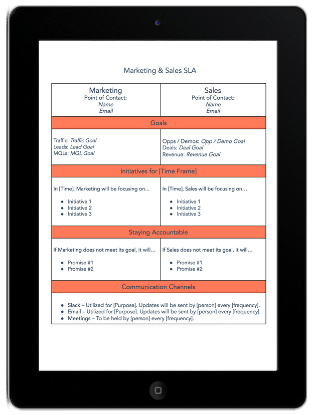
In many ways, a traditional sales plan is already aligned with marketing. Still, you can create a marketing-alignment sales plan if your organization has not yet aligned both of these departments.
The plan's focus will be on establishing ideal customer profiles and buyer personas and aligning marketing's messaging with sales' product pitch. A strong marketing-sales alignment ensures everyone within your organization is on the same page and reduces miscommunication down the line.
Business Development Strategic Sales Plan
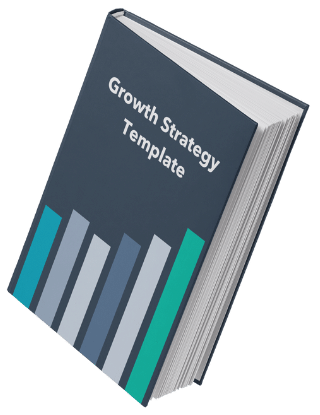
A strategic sales plan for business development will focus on attracting new business to your company by networking with other companies, sponsoring events, and doing outreach. In your sales plan, you'll want to choose the right KPIs that best reflect performance for these specific outreach channels.
Business development is imperative for long-term success because it will help your organization better understand your industry's competitive landscape and strategize on how to stand out. Plus, it ensures that everyone at your company is working toward a common goal.
Market Expansion Plan

A market expansion plan outlines a task list and target metrics when expanding into a new market or territory. This type of sales plan is specifically concerned with addressing a target market in a new geographical area.
You'll typically take into account distribution costs and, if applicable, time zone differences between your sales representatives and target buyers, as well as other logistical factors.
New Product Sales Plan

If you're launching a new product, create a sales plan specifically to generate revenue from the new launch. It'll be crucial to carry out competitive analysis, determine a sales strategy, strengthen your brand positioning, and secure channel partners if you're shifting to a channel sales model.
Strategic Sales Plan Examples
If you're in need of some more inspiration, take a look at these sales plan examples.
1. Sales Plan Template by RocDesk

We've created a sales plan template that outlines the key elements of a sales plan. This template will walk you through each of the steps to write a sales plan of your own.
Our plan allows you to easily communicate to your organization what your goals are, how you'll accomplish them, and what support you need.
2. Sample Sales Plan by BestTemplates

Organizing your strategies and goals with a sales plan will make it easier for you and your sales team to stick to the targets you've set. This template is nine pages long and provides plenty of opportunities to create a concrete action plan.
We like it because it includes a goals section before breaking it down into more specific areas such as demand generation, implementation, and measurement and evaluation. This
3. Asana Sales Plan
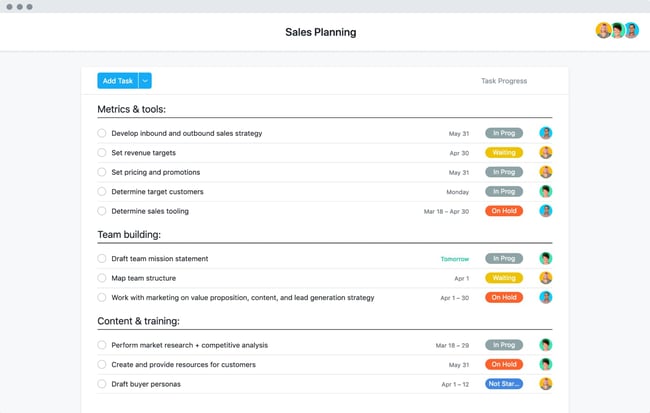
If you use Asana's project management software, this template is for you. Embed this template where your team works and communicates to keep everyone aligned with your sales strategy.
The great thing about Asana is that you can assign tasks to team members and see how you are progressing toward your goals in real-team.
4. 1-Page Sales Plan by BestTemplates
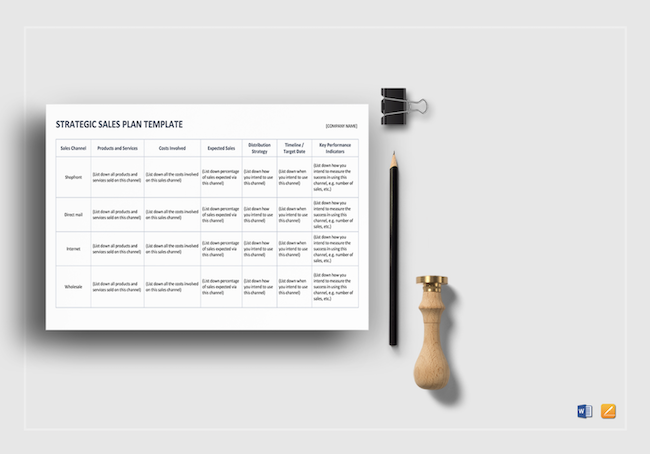
A sales plan doesn't need to be hundreds of pages long. Try consolidating your sales plan to a page or two. This template is an excellent example of making it short and sweet while still communicating the most important elements of the plan.
In landscape mode, this strategic sales plan includes a channel, expected costs and sales, distribution strategy, and key performance indicators in an easy-to-read grid layout.
5. Online Sales Plan Maker Map by Venngage
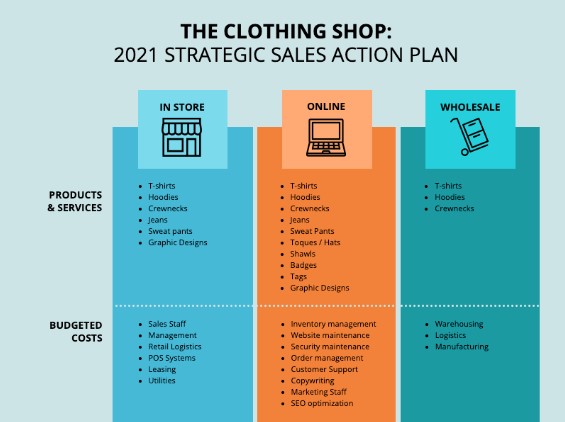
Choose a design that fits your needs and create your sales plan using Venngage's interface which includes custom charts, stock photos, and illustrations. You'll have several visually interesting options, all available in just a single tool.
We like this plan because it's organized by type of sale: in store, online, and wholesale. This makes it easier to identify each sales channel's needs and which departments contribute to their success.
6. Small Business Sales Plan by FitSmallBusiness
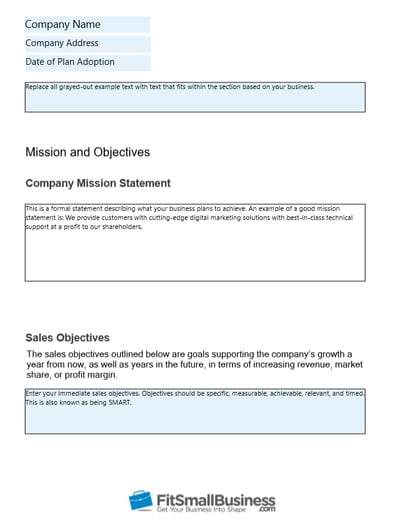
If you run a small business, you may not yet have a fully stacked sales team. It's likely that you and your employees wear many hats, so it's important to establish a strong sales strategy for your company that future hires can build off of.
Sometimes simpler is better, so this plan relies on several standard sections to draw up your plan, with boxes that can be easily filled out using Microsoft Word or Google Docs.
7. Sales Strategy Diagram from Creately
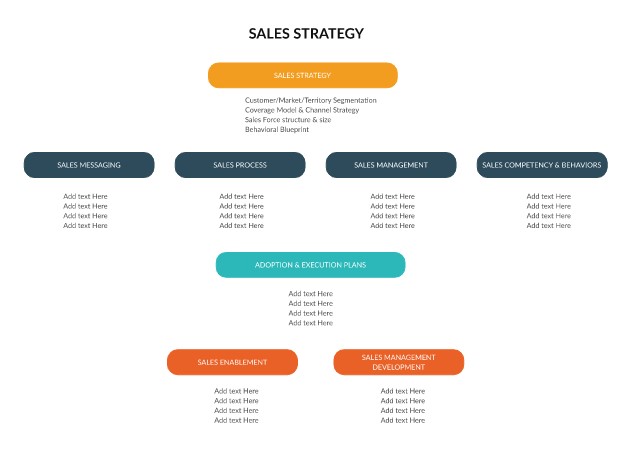
If you're more of a visual person, creating a diagram for your sales strategy can be helpful. Use Creately to create an attractive sales strategy to share with your team.
We like this template because it allows you to map out the key elements of your strategy by breaking action items and values down by category.
8. Sales Action Plan by BestTemplates

Dive into the details of your sales strategy with a sales action plan. It has a minimalistic but super clean layout.
This sales action plan is effective because it focuses on the more concrete elements of achieving your sales goals, such as positioning and strategic plays. It is eight pages long and fully customizable in either Word or Pages.
9. 30-60-90 Day Sales Plan by Template.Net
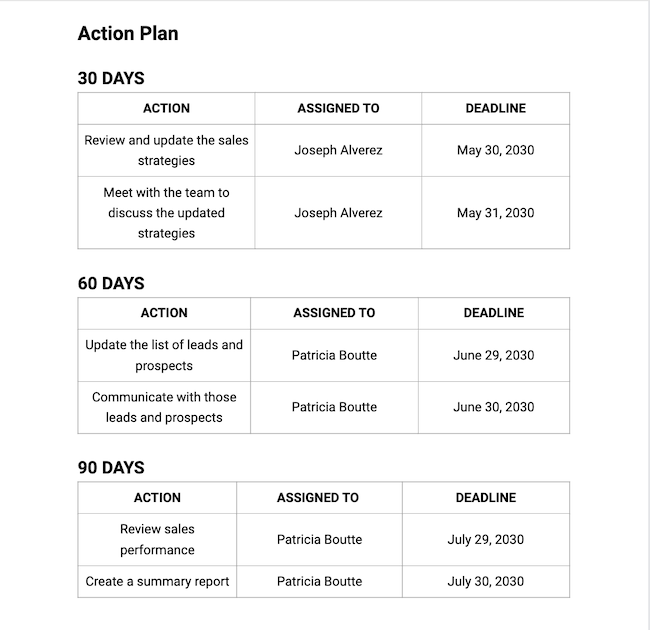
We love 30-60-90 day plans because it allows you to set a realistic pace for accomplishing your goals, whether they are short- or long-term.
This sales plan does some of the work for you by outlining tasks related to your sales goals. You can check off boxes as you complete each item to ensure you're creating a sound sales strategy.
10. Microsoft Word Sales Plan Template from TemplateLab
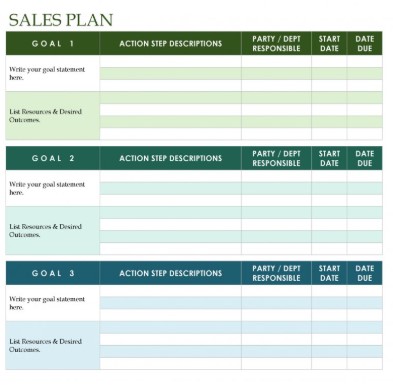
This template breaks down goals into action items, helps you think about how to assign responsibilities, and gets you to commit to specific dates.
The best part is that it focuses on multiple goals, giving you a bird's eye view of several initiatives you may be putting together.
11. 90-Day Sales Plan by Template.Net
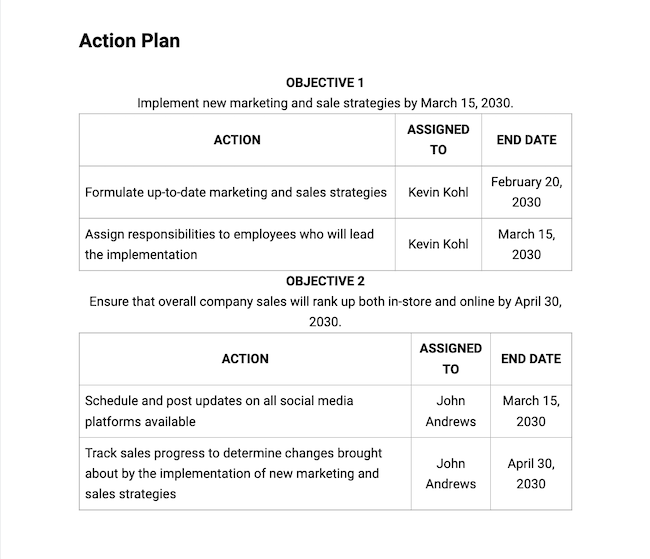
Look ahead at your sales strategies for the next 90 days using this sample sales plan. In this document, you'll be able to break your sales plan down into phases, tasks, and key questions for your sales goals. The final section is a mind map for your sales process and pipeline strategies, which is especially great for brainstorming.
Create a Sales Plan that Grows with Your Business
There's no one-size-fits-all sales plan. The only wrong way to use a sales plan is to write it at the start of the year or quarter and never touch it again. You should periodically review and update it as time goes on to ensure you're focused and on track. By continuously improving on your plan, you can ensure your company generates revenue more effectively than it ever did in the past.
Editor's note: This post was originally published in December 2019 and has been updated for comprehensiveness.


























